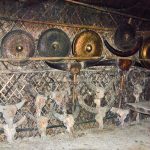India’s North-East provinces have over 2000 km of border with Bhutan, China, Myanmar and Bangladesh and are connected to the rest of India by a narrow 20 km wide corridor of land. They seem like an alien element regarding the rest of the Indian subcontinent – and indeed, this is exactly what they are!
The majority of the almost 40 Mio. inhabitants of the 7 Indian states, also known as „Seven Sisters“, belong to numerous ethnic groups, which clearly differ from the rest of India in terms of culture and religion. Because of that, they belong to one of the most ethnically and linguistically diverse regions in Asia. The people are anxious to hold on to their ways of living and scrupulously avoid being patronized by far-away Delhi. There, on the other hand, the government takes care not to loosen the reins in this very sensible border region. And there was a time when India did not maintain „amicable“ relations to any of the North-East provinces and still does not at times…
When India became independent in 1947 from colonial England, there were only 3 states: Manipur and Tripura which were princely states and the huge territory of Assam, which was under British reign. After independency, India created four new states out of Assam along ethnic and linguistic lines, and thus one-by-one Nagaland, Meghalaya, Mizoram and Arunachal Pradesh were formed. Tripura followed later.
Ever since, this part of India suffered from insurgency, uproar, intra-tribal warfare and terror . Whereas some parts want a seperate state, others seek for local autonomy, and others again demand complete independence.
Already in the 1960s and 1970s a lot of underground organizations had built up, which fought for independency in their region with terrorist-like violence, like the Tripura National Volonteers.
Quite a few times in history, the Indian government has placed the so-called President’s Rule, which means, they deposed the according local governments and made them subordinate to India’s central regime. Of course, this was not a good solution which would work for the future..
In the mid 80s violence escalated when thousands of Bangladeshis, due to economic misery, fled from their homeland and swepped into the North-Eastern territory. Serious tensions started to build up between the locals who feard their ethnic identity and their economic privileges, and the new immigrants. It was in 1983, when all the tensions erupted with massive force and ended in brutal massacres: thousands of people had died in the streets…
Then later, the newly formed United Liberation Front of Assam (ULFA) who fought for an independent Assam, added serious defeats to the Indian army. And, in 1991, as again thousands of refugees came into Mizoram, Meghalaya and Nagaland, this time from Myanmar, insurgencies started again and the whole region was in sheer uproar.
Delhi tried to calm the situation not only by political means, but there does not seem to be an end to the riots in foreseeable future.
In the last decades it was not always easy for tourist to visit the North-East provinces, as riots went on everywhere, and still do in parts from time to time.
And just because the area still is comparativly rarely visited by tourists, old traditions could live on without major influence.
We were lucky to visit Assam, Meghalaya, Nagaland and Arunachal Pradesh – and very lucky on top, to see quite a few of the most interesting ethnics living in the remote areas there.
In my following blogs I will talk about who they are, how they live, their social life, their traditions and much more.
So, my next story will be about the fascinating Naga tribe – one of India’s many ethnic groups living high up in the secluded province, called Nagaland, famous for their warriors and headhunters…




